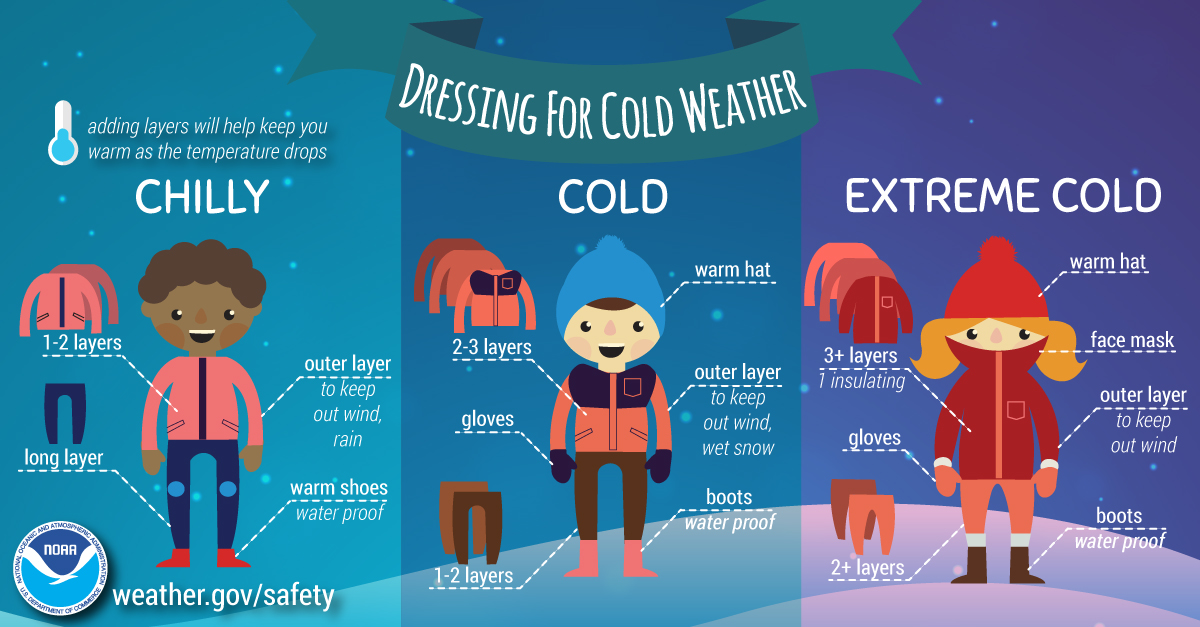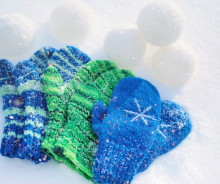Prepare for Extreme Cold
Immediate Resources
- A list of local warming centers and shelters can be found at: Emergency Services Guide | City of Urbana (urbanaillinois.us).
- If you begin to feel anxious, lonely or in need of support while you shelter in place during extreme weather events, call the free 24-hour Disaster Distress Helpline at 1-800-985-5990 (a resource of the Substance Abuse and Mental Health Services Administration).
Dress for Cold Weather
- Dress in layers.
- Mittens are better than gloves.
- Keep your skin dry.

Watch for Frostbite and Hypothermia
 Frostbite happens when the body's survival mechanisms kick in during extremely cold weather. To protect the vital inner organs, the body cuts circulation to your extremities: feet, hands, nose, etc., which eventually freeze. To avoid frostbite, stay inside during severe cold, especially when the windchill is -50°F or below. If you must go out, try to cover every part of your body: ears, nose, toes and fingers, etc. If you suspect frostbite is occurring, get indoors as quickly as possible. Until you can get indoors:
Frostbite happens when the body's survival mechanisms kick in during extremely cold weather. To protect the vital inner organs, the body cuts circulation to your extremities: feet, hands, nose, etc., which eventually freeze. To avoid frostbite, stay inside during severe cold, especially when the windchill is -50°F or below. If you must go out, try to cover every part of your body: ears, nose, toes and fingers, etc. If you suspect frostbite is occurring, get indoors as quickly as possible. Until you can get indoors:
- Don't rub or massage cold body parts.
- Put your hands in your armpits.
- Hold onto another person or animal.
- Drink warm liquids.
- Put on extra layers of clothes, blankets, etc.
- Remove rings, watches and anything other tight jewelry or related items.
Once indoors:
- Don't walk on a frostbitten foot. You could cause more damage.
- Get in a warm, NOT hot, bath and wrap your face and ears in a moist, warm, NOT hot, towel.
- Don't get near a hot stove or heater or use a heating pad, hot water bottle, or a hair dryer. You may burn yourself before feeling returns.
- Frostbitten skin will become red and swollen and feel like it's on fire. You may develop blisters. Don't break the blisters. It could cause scarring and infection.
- If your skin turns blue or gray, is very swollen, blistered or feels hard and numb even under the surface, go to a hospital as soon as possible.
 When your body temperature sinks below 96°F, you have hypothermia, a serious health hazard that occurs when body temperature is lowered too much. Hypothermia can occur in temperatures as warm as 60°F, particularly in water or with if you are outside a long time and not dressed for the weather. Of the approximately 1,300 people who die from hypothermia each year, most are seniors, according to the National Institute of Aging, but some are children and young adults. Everyone needs to be careful. Some medicines, problems with circulation, and certain illnesses may reduce your ability to resist hypothermia. As you age, your body becomes less efficient at letting you know when you are too cold. In addition, older people tend not to shiver effectively, one of the ways the body warms itself up. To help prevent hypothermia:
When your body temperature sinks below 96°F, you have hypothermia, a serious health hazard that occurs when body temperature is lowered too much. Hypothermia can occur in temperatures as warm as 60°F, particularly in water or with if you are outside a long time and not dressed for the weather. Of the approximately 1,300 people who die from hypothermia each year, most are seniors, according to the National Institute of Aging, but some are children and young adults. Everyone needs to be careful. Some medicines, problems with circulation, and certain illnesses may reduce your ability to resist hypothermia. As you age, your body becomes less efficient at letting you know when you are too cold. In addition, older people tend not to shiver effectively, one of the ways the body warms itself up. To help prevent hypothermia:- Dress in layers
- Eat nutritious food and wear warm clothes to ward off winter chill.
- Wear a warm hat in the winter.
- Eat hot foods and drink warm drinks several times during the day.
- Call your neighbors. Check to see that your neighbors are okay, particularly seniors, disabled persons or others living alone.
- If you live alone, ask a family member of neighbor to check on you daily or have a camera installed that a family member can view on their computer.
- For more tips on staying safe during cold weather for older adults, visit the National Institutes of Health's page on Cold Weather Safety for Older Adults.
If you suspect hypothermia is occuring, seek medical attention immediately. Call an ambulance. Move the victim inside to a heated location and begin warming the center of the body first. If the person is unconscious, administer CPR. Then lie close to the person and cover both of you with thick blankets. The hotter you get, the more warmth you can give the other person. Don't rub the person or handle them roughly.
Care for Your Home and Vehicle

Your home:
- Open kitchen and bathroom cabinet doors to allow warmer air to circulate around the plumbing. Be sure to move any harmful cleaners and household chemicals up out of the reach of children.
- Let the cold water drip from the faucet served by exposed pipes. Running water through the pipe - even at a trickle - helps prevent pipes from freezing.
- Water pipes on exterior walls and in places that are subject to cold, like in the basement, attic, and under kitchen cabinets, freeze most often. Water expands as it freezes, causing pipes to burst. If they are frozen, first turn on the faucet. Water will drip as you warm the pipes. Heat the pipes using a space heater, heating pad, electric hair dryer, or hot water on a cloth. Never use an open flame. Continue until water pressure returns to normal or call a plumber if you have more issues. Do not use a blowtorch, kerosene or propane heater, charcoal stove, or other open flame device.
- For more tips on home safety during winter weather, visit the American Red Cross.
Your vehicle:
- Make sure your car or vehicle has at least a half a tank of gas during extreme cold situations so that you can stay warm if you become stranded.
- Update your winter car survival kit; make sure it has non-perishable food like energy bars, as well as bottled water, cat litter or sand for better tire traction, extra clothes, a shovel, first aid kit, and blankets. For additional winter car survival tips, visit: www.weather.gov/safety/cold-before.
Keep Pets Safe

For more tips on cold weather safety, visit: www.weather.gov/safety/cold.
Click on location marker to view address.
Map Locations:
Contributors:
